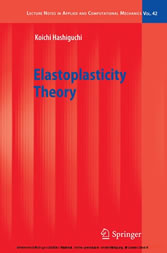Search and Find
Service
Title Page
2
Preface
6
Contents
11
Tensor Analysis
16
Conventions and Symbols
16
Vector
23
Tensor
29
Operations of Second-Order Tensor
35
Eigenvalues and Eigenvectors
41
Calculations of Eigenvalues and Eigenvectors
46
Eigenvalues and Eigenvectors of Skew-Symmetric Tensor
48
Cayley-Hamilton’s Theorem
50
Positive Definite Tensor
50
Polar Decomposition
51
Isotropic Tensor-Valued Tensor Function
52
Representation of Tensor in Principal Space
55
Two-Dimensional State
59
Partial Differential Calculi
62
Time Derivatives
65
Differentiation and Integration in Field
66
Motion and Strain (Rate)
72
Motion and Deformation
72
Strain Tensor
79
Strain Rate and Spin Tensors
85
Various Simple Deformations
96
Surface Element, Volume Element and Their Rates
112
Conservation Laws and Stress Tensors
115
Conservation Law of Mass
115
Conservation Law of Momentum
115
Conservation Law of Angular Momentum
116
Stress Tensor
116
Equilibrium Equation
119
Equilibrium Equation of Moment
121
Virtual Work Principle
122
Objectivity and Corotational Rate Tensor
124
Objectivity
124
Influence of Rigid-Body Rotation on Various Mechanical Quantities
125
Rate of State Variable and Corotational Rate Tensor
127
Transformation of Material-Time Derivative of Scalar Function to Its Corotational Derivative
132
Various Objective Stress Rate Tensors
135
Work Conjugacy
137
Elastic Constitutive Equations
139
Hyperelasticity
139
Cauchy Elasticity
142
Hypoelasticity
143
Basic Formulations for Elastoplastic Constitutive Equations
146
Multiplicative Decomposition of Deformation Gradient and Additive Decomposition of Strain Rate
146
Conventional Elastoplastic Constitutive Equations
153
Loading Criterion
159
Associated Flow Rule
162
Anisotropy
167
Incorporation of Tangential-Inelastic Strain Rate
170
Hyperelastic-Plastic Constitutive Equation: Finite Strain Theory
176
Unconventional Elastoplasticity Model: Subloading Surface Model
182
Mechanical Requirements
182
Subloading Surface Model
185
Salient Features of Subloading Surface Model
192
On Bounding Surface and Bounding Surface Model
195
Incorporation of Anisotropy
197
Incorporation of Tangential Inelastic Strain Rate
198
Cyclic Plasticity Model: Extended Subloading Surface Model
201
Classification of Cyclic Plasticity Models
201
Translation of Subyield Surface(s): Extension of Kinematic Hardening
201
Extended Subloading Surface Model
206
Modification of Reloading Curve
215
Incorporation of Tangential-Inelastic Strain Rate
218
Viscoplastic Constitutive Equations
220
History of Viscoplastic Constitutive Equations
220
Mechanical Response of Ordinary Overstress Model
223
Modification of Overstress Model: Extension to General Rate of Deformation
224
Incorporation of Subloading Surface Concept: Subloading Overstress Model
226
Constitutive Equations of Metals
230
Isotropic and Kinematic Hardening
230
Cyclic Stagnation of Isotropic Hardening
234
On Calculation of the Normal-Yield Ratio
241
Comparisons of Test Results
241
Orthotropic Anisotropy
247
Representation of Isotropic Mises Yield Condition
253
Plane Stress State
254
{\it Plane Strain State}
257
Constitutive Equations of Soils
258
Isotropic Consolidation Characteristics
258
Yield Conditions
262
Isotropic Hardening Function
268
Rotational Hardening
270
Extended Subloading Surface Model
274
Partial Derivatives of Subloading Surface Function
276
Calculation of Normal-Yield Ratio
280
Simulations of Test Results
284
Simple Subloading Surface Model
290
Super-Yield Surface for Structured Soils in Natural Deposits
300
Numerical Analysis of Footing Settlement Problem
310
Corotational Rate Tensor
317
Hypoelasticity
317
Kinematic Hardening Material
321
Plastic Spin
325
Localization of Deformation
334
Element Test
334
Gradient Theory
335
Shear-Band Embedded Model: Smeared Crack Model
338
Necessary Condition for Shear Band Inception
340
Numerical Calculation
344
Numerical Ability of Subloading Surface Model
344
Return-Mapping Formulation for Subloading Surface Model
347
Constitutive Equation for Friction
355
History of Constitutive Equation for Friction
355
Decomposition of Sliding Velocity
356
Normal Sliding-Yield and Sliding-Subloading Surfaces
360
Evolution Rules of Sliding-Hardening Function and Normal Sliding-Yield Ratio
361
Relations of Contact Traction Rate and Sliding Velocity
363
Loading Criterion
365
Sliding-Yield Surfaces
366
Basic Mechanical Behavior of Subloading-Friction Model
371
Extension to Orthotropic Anisotropy
381
Appendixes
393
Appendix 1: Projection of Area
393
Appendix 2: Proof of $\partial(F_{jA} / J) / \partial{x}_{j}$=0
394
Appendix 3: Euler’s Theorem for Homogeneous Function
394
Appendix 4: Normal Vector of Surface
395
Appendix 5: Convexity of Two-Dimensional Curve
396
Appendix 6: Derivation of Eq. (11.19)
397
Appendix 7: Numerical Experiments for Deformation Behavior Near Yield State
398
References
400
Index
411
All prices incl. VAT












